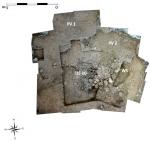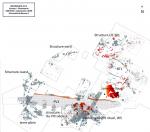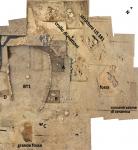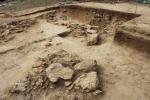Summary (English)
This season’s campaign took a closer look at several questions regarding chronology, topography, and function, in addition to opening new and fundamental research areas.
The excavation of the structure, probably delimited to the south by a line of stones, was deepened and extended (fig. 2). The latter is situated in the area south of the large 8th century (PV2) and late 8th-early 7th century B.C. (PV1) floors (fig. 1), to the west of the ritual space constituted by the association of a large white stone (WS)/cobblestones/deposition of bones and Enotrian geometric pottery. Substantial concentrations of small cubes of blackish clay (US 86) were found inside the structure, which could belong to the mud brick walls, together with a large amount of 8th century B.C. Enotrian pottery, associated with large body sherds and rims from large pithoi. This building (as things stand) seems to have been destroyed, and therefore obliterated by the creation of the ritual space described above. Such an operation would confirm the cult’s importance, as suggested by the quality and quantity of the pottery found there.Further north, work continued on the structures in the workshop area (fig. 1, “zones des fours”), where samples were taken for archeo-magnetic analyses. Occupation levels pre-dating the 7th century B.C. phases were intercepted and at least one new kiln identified.
In the apsidal building (fig. 1 and 3, BT1), micro-stratigraphic excavation completed the removal of the pottery from the “mixed” ritual deposition at the centre of the apse (completing the almost total reconstruction of the 7th century B.C. Greek and Enotrian vases found within it. The deposition rested directly on natural. To the exterior, along the line of stones delimiting the wall of the building, several post holes were identified, which probably housed the supporting structures for the roof (fig. 3); C and D are certain; A and B are still to be checked.
In the area east of the apsidal building, excavation continued of a large pit that opened in front of the entrance, and of the area adjacent to it (fig. 3). This confirmed that the pit walls were lined with “carpets” of minuscule cobblestones, which also formed the surfaces of the adjacent spaces, and the probable creation of several pits, partially re-excavated one within another at different times.The excavation of the large wall north of the apsidal building was extended. Perfectly aligned east-west (figs. 1 and 3, US 381), its foundations are formed by large stone blocks resting directly on the clay soil. To the east, where it is less well-preserved, occupation surfaces, new pits and a large concentration of pottery fragments were uncovered. The continuation of work in this area next year will no doubt provided important data regarding stratigraphy and chronology. The wall continued towards the west, on the same alignment as the section exposed last year (figs. 3 and 4) and using the same construction technique. A large concentration of stones and cobbles was present in the north corner of the trench, which seems to suggest the existence of a structure on a different alignment, but perhaps associated with the wall. In this area also, a substantial collapse of large bricks (figs. 3 and 4) continued to run parallel to the wall in question. The collapse was probably formed by the walls of this monumental construction, which was also (like all the other structures relating to the final occupation phase), methodically demolished at the moment the site was abandoned.
- Mario Denti - Université de Rennes 2, UMR 6566 CReAAH
Director
Team
- Paul Lagarrigue - Université Rennes 2
- Cesare Vita - Laboratoire LAHM, UMR 6566 CReAAH, Université Rennes 2/Università della Basilicata
- Clément Bellamy- Laboratoire LAHM, UMR 6566 CReAAH, Université Rennes 2
- Emmanuelle Smirou- Laboratoire LAHM, UMR 6566 CReAAH, Université Rennes 2
- Josipa Mandic - Laboratoire LAHM, UMR 6566 CReAAH, Université Rennes 2/Università della Basilicata
- Mathilde Villette-Laboratoire LAHM, UMR 6566 CReAAH, Université Rennes 2
Research Body
- Laboratoire LAHM - UMR 6566 CReAAH, Université Rennes 2
Funding Body
- Laboratoire LAHM
- Université Rennes 2






![Download [PDF]](/excavation/skins/fasti/images/results/download_sml.png)


